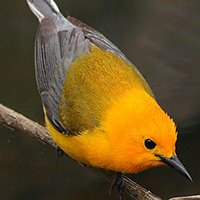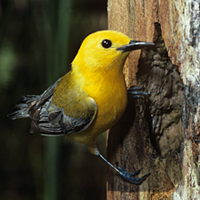Prothonotary warbler
Scientific name: Protonotaria citrea


Cover photo credits: Allen Woodliffe (all photos)
Status
Endangered
“Endangered” means the species lives in the wild in Ontario but is facing imminent extinction or extirpation.
Date added to the Species at Risk in Ontario List
The Prothonotary warbler was already assessed as endangered when the Endangered Species Act came into effect in 2008. A reassessment in May 2017 confirmed this status.
Read the assessment report PDF.
What it looks like
The Prothonotary warbler is a stunningly beautiful songbird with a brilliant golden-yellow head, throat, and belly. The back is olive-green and the wings, rump and tail are dark blue-grey.
The tail shows prominent white spots when spread. Females and juveniles are similar to males, but not as brightly coloured.
This species also has an unusually large beak compared to other warblers, which it uses to excavate nesting cavities in rotten wood.
Its song is a very clear and rapidly delivered, "Tsweet-tsweet-tsweet-tsweet".
Where it lives
The Prothonotary warbler nests in small, shallow holes, found low in the trunks of dead or dying trees standing in or near flooded woodlands or swamps.
They will also readily use properly placed artificial nest boxes.
Silver maple, ash, and yellow birch are common trees in these habitats.
The Prothonotary is the only warbler in eastern North America that nests in tree cavities, where it typically lays four to six eggs on a cushion of moss, leaves and plant fibres.
Where it’s been found in Ontario
In Canada, the Prothonotary warbler is only known to nest in southwestern Ontario, primarily along the north shore of Lake Erie. Over half of the small and declining population is found in Rondeau Provincial Park.
In Ontario, the Prothonotary warbler is found in the warmer climate of the Carolinian deciduous forests.
In 2005, it was estimated that there were only between 28-34 individuals in Ontario.
View a Larger version of this map (PDF)
What threatens it
The main threats to the Prothonotary warbler are habitat destruction caused by the removal of dead and living trees, and the draining of the forested swamps that make up their exclusive habitat.
Another concern is the continuing loss of wintering habitat, especially mangrove swamps, in Central and South America.
Competition from other birds, like the House wren and Brown-headed Cowbird, is a threat in some areas.
Natural factors, such as climate change, storms, and extremes in water levels are also potential issues.
Action we are taking
Endangered species and their general habitat are automatically protected
Recovery strategy
A recovery strategy advises the ministry on ways to ensure healthy numbers of the species return to Ontario.
Read the executive summary (June 15, 2012)
Read the recovery strategy (June 15, 2012)
Government response statement
A government response statement outlines the actions the government intends to take or support to help recover the species.
Read the government response statement (May 31, 2013)
Five-year review of progress
A five-year review of progress made toward protecting and recovering a species is required no later than five years after the government response statement for that species is published.
Read the report on progress towards the protection and recovery of 17 species at risk, including the Prothonotary Warbler (2018).
Habitat protection
General habitat protection - June 30, 2008
What you can do
Report a sighting
- the Ministry of Natural Resources and Forestry tracks species at risk such as the Prothonotary warbler; Report a sighting of an endangered animal or plant to the Natural Heritage Information Centre. Photographs with specific locations or mapping coordinates are always helpful.
- Bird Studies Canada is working to advance the understanding, appreciation and conservation of wild birds and their habitat in Ontario and elsewhere; for more information on how you can help, visit:
www.bsc-eoc.org. - the Carolinian forests of southern Ontario support an amazing diversity of plants and wildlife, including many species at risk; Carolinian Canada is working to help recover species at risk and their habitats; for more information, visit:
www.www.carolinian.org/SpeciesHabitats.htm.
Volunteer
Volunteer with your local nature club or provincial park to participate in surveys or stewardship work focused on species at risk.
Be a good steward
Private land owners have a very important role to play in species recovery. If you find a Prothonotary warbler on your land, you may be eligible for stewardship programs that support the protection and recovery of species at risk and their habitats.
Report illegal activity
Report any illegal activity related to plants and wildlife to
Quick facts
- the Prothonotary warbler was named after legal clerks in the Roman Catholic Church, known as prothonotaries, who sometimes wear a golden hood and a blue cape
- this warbler is considered one of the most dazzling birds in North America due to its stunning colouration and its habit of feeding along pond edges where it constantly sees its reflection, making it doubly beautiful; one very appropriate folk name for this bird is “swamp candle”
- Prothonotary warblers spend the winter in the warm, tropical climate of Central and South America; the coastal mangrove forests they favour are one of the most endangered habitats in the world
